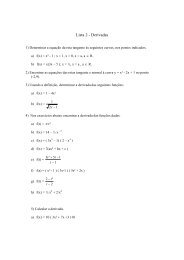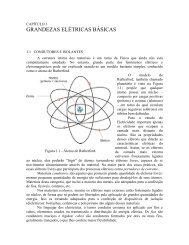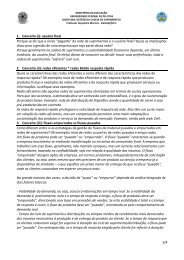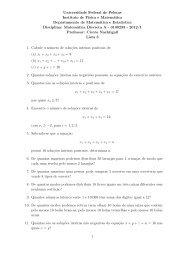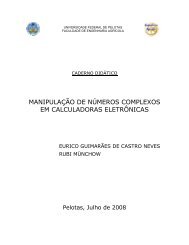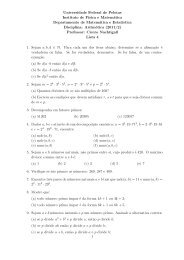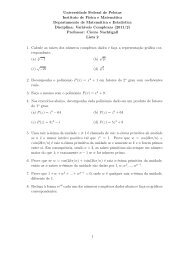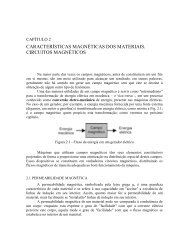Lista 05 - Minerva.ufpel.tche.br - Universidade Federal de Pelotas
Lista 05 - Minerva.ufpel.tche.br - Universidade Federal de Pelotas
Lista 05 - Minerva.ufpel.tche.br - Universidade Federal de Pelotas
You also want an ePaper? Increase the reach of your titles
YUMPU automatically turns print PDFs into web optimized ePapers that Google loves.
<strong>Universida<strong>de</strong></strong> <strong>Fe<strong>de</strong>ral</strong> <strong>de</strong> <strong>Pelotas</strong><<strong>br</strong> />
Instituto <strong>de</strong> Física e Matemática<<strong>br</strong> />
Departamento <strong>de</strong> Matemática e Estatística<<strong>br</strong> />
Disciplina: Matemática Discreta A - 0100233 - 2012/1<<strong>br</strong> />
Professor: Cícero Nachtigall<<strong>br</strong> />
<strong>Lista</strong> 5<<strong>br</strong> />
1. Encontre a função geradora ordinária para cada uma das sequências abaixo:<<strong>br</strong> />
(a) (1, 1, 1, 0, 0, 0, 0, ...) (d) (0, 0, 1, 1, 1, ...) (g) (1, −1, 1, −1, 1, −1, ...)<<strong>br</strong> />
(b) (1, 0, 0, 2, 3, 0, 0, 0, 0...) (e) (0, 1, 0, 1, 0, 1, ...) (h) (1, −1, 1<<strong>br</strong> />
2!<<strong>br</strong> />
(c) (1, 1, 1, 3, 1, 1, ...) (f) (0, 4, 0, 4, 0, 4, ...) (i) (ak) =<<strong>br</strong> />
, − 1<<strong>br</strong> />
3!<<strong>br</strong> />
2. Encontre a sequência gerada pelas funções geradoras ordinárias dadas abaixo:<<strong>br</strong> />
(a) (x + 1) 4 (e) e 2x + x + x 2 (i) x 3 (1 − 4x) −1<<strong>br</strong> />
(b) x + e x (f) x 2 e x (j) e −2x<<strong>br</strong> />
(c) x 2 (1 − 3x) −1 (g)<<strong>br</strong> />
1<<strong>br</strong> />
1 + x 2<<strong>br</strong> />
3 k<<strong>br</strong> />
k!<<strong>br</strong> />
<<strong>br</strong> />
(k) ex + e −x<<strong>br</strong> />
2<<strong>br</strong> />
(d) 1+(1−x 2 ) −1 (h) e −x +3x (l) (1+x) q , q ∈ Z ∗ +<<strong>br</strong> />
3. Encontre o coeficiente <strong>de</strong> <strong>de</strong> x 6 em (1 − x) n , quando n = 6 e quando n = −6.<<strong>br</strong> />
4. Encontre o coeficiente <strong>de</strong> <strong>de</strong> x 27 em (x 3 + x 4 + x 5 + ...) 6 .<<strong>br</strong> />
5. Encontre o número <strong>de</strong> maneiras <strong>de</strong> se obter um total <strong>de</strong> 15 pontos ao se jogar,<<strong>br</strong> />
simultaneamente, quatro dados diferentes.<<strong>br</strong> />
, 1<<strong>br</strong> />
4!<<strong>br</strong> />
1 , − , ...) 5!<<strong>br</strong> />
6. Representantes <strong>de</strong> três institutos <strong>de</strong> pesquisa <strong>de</strong>vem formar uma comissão <strong>de</strong> 9<<strong>br</strong> />
pesquisadores. De quantos modos po<strong>de</strong> ser formada esta comissão sendo que nenhum<<strong>br</strong> />
instituto <strong>de</strong>ve ter maioria absoluta no grupo?<<strong>br</strong> />
7. Existem 10 caixas idênticas <strong>de</strong> presentes. Cada uma <strong>de</strong>ve ser em<strong>br</strong>ulhada com<<strong>br</strong> />
uma única cor e se dispõe <strong>de</strong> papéis <strong>de</strong> cor vermelha, azul, ver<strong>de</strong> e amarela. O<<strong>br</strong> />
papel vermelho permite que se em<strong>br</strong>ulhe no máximo duas caixas e com o azul se<<strong>br</strong> />
po<strong>de</strong> em<strong>br</strong>ulhar no máximo três. Escreva a função geradora ordinária associada ao<<strong>br</strong> />
problema <strong>de</strong> se encontrar o número <strong>de</strong> maneiras <strong>de</strong> se em<strong>br</strong>ulhar estas 10 caixas.<<strong>br</strong> />
8. Encontre a função geradora ordinária para se calcular o número <strong>de</strong> soluções em<<strong>br</strong> />
inteiros não negativos da equação<<strong>br</strong> />
2x + 3y + 4z + 5w = r.<<strong>br</strong> />
9. Encontre o número <strong>de</strong> soluções em inteiros da equação<<strong>br</strong> />
x + y + z + w = 25,<<strong>br</strong> />
on<strong>de</strong> cada variável é no mínimo 3 e no máximo 8.<<strong>br</strong> />
1
10. Numa competição, cada um dos quatro juízes <strong>de</strong>ve atribuir notas <strong>de</strong> 1 a 6 para cada<<strong>br</strong> />
participante. Para ser finalista, um participante <strong>de</strong>ve ter no mínimo 22 pontos.<<strong>br</strong> />
Encontre o número <strong>de</strong> maneiras que os juízes tem para atribuir notas <strong>de</strong> modo que<<strong>br</strong> />
um participante seja finalista.<<strong>br</strong> />
11. Quantas soluções possui a equação<<strong>br</strong> />
se cada variável é igual a 0 ou 1.<<strong>br</strong> />
x1 + x2 + x3 + x4 + ... + xn = r,<<strong>br</strong> />
12. Encontre o número <strong>de</strong> maneiras <strong>de</strong> se distribuir 11 laranjas e 6 pêras para 3 crianças<<strong>br</strong> />
<strong>de</strong> modo que cada criança receba pelo menos 3 laranjas e no máximo 2 pêras.<<strong>br</strong> />
13. Quantas n-uplas <strong>de</strong> 0 ′ s e 1 ′ s po<strong>de</strong>m ser formadas usando-se um número par <strong>de</strong> 0 ′ s<<strong>br</strong> />
e um número par <strong>de</strong> 1 ′ s?<<strong>br</strong> />
14. (a) Uma companhia telefônica adquire 9 computadores idênticos. De quantas maneiras<<strong>br</strong> />
ela po<strong>de</strong> distribuir estes 9 computadores para 4 direfentes escritórios <strong>de</strong> modo que<<strong>br</strong> />
cada um receba pelo menos um novo computador?<<strong>br</strong> />
(b) Uma companhia telefônica contrata 9 novos técnicos. De quantas maneiras<<strong>br</strong> />
diferentes ela po<strong>de</strong> alocar estes 9 empregados para 4 diferentes escritórios <strong>de</strong> forma<<strong>br</strong> />
que cada escritório receba pelo menos um novo técnico?<<strong>br</strong> />
15. Encontre a função geradora exponencial para cada uma das sequências:<<strong>br</strong> />
(a) (1, 1, 1, 0, 0, 0, 0, 0, ...) (b) (1, 3, 3 2 , 3 3 , ...) (c) (0, 2, 0, 2, 0, 2, ...)<<strong>br</strong> />
16. Encontre a função geradora ordinária para a sequência<<strong>br</strong> />
ak = 1 + 2 + 2 2 + 2 3 + ... + 2 k .<<strong>br</strong> />
17. Uma sequência quaternária é uma r-upla formada somente pelos dígitos 0, 1, 2 e<<strong>br</strong> />
3. Quantas são as r-sequências quaternárias nas quais o número <strong>de</strong> 0 ′ s é par e o<<strong>br</strong> />
número <strong>de</strong> 1 ′ s também é par?<<strong>br</strong> />
18. De quantas maneiras po<strong>de</strong>mos distribuir 300 ca<strong>de</strong>iras idênticas em 4 salas <strong>de</strong> modo<<strong>br</strong> />
que o número <strong>de</strong> ca<strong>de</strong>iras em cada sala seja 20 ou 40 ou 60 ou 80 ou 100?<<strong>br</strong> />
19. Encontre a função geradora ordinária para o número <strong>de</strong> partições <strong>de</strong> n em que todas<<strong>br</strong> />
as partes são ímpares e nenhuma supera 7.<<strong>br</strong> />
20. Uma sequência ternária é uma r-upla formada somente pelos dígitos 0, 1 e 2. Encontre<<strong>br</strong> />
o número <strong>de</strong> r-sequências ternárias nas quais o número <strong>de</strong> 0 ′ s é par.<<strong>br</strong> />
21. Dê uma interpretação, em termos <strong>de</strong> partições, para:<<strong>br</strong> />
(a) O coeficiente <strong>de</strong> x 12 na expansão <strong>de</strong><<strong>br</strong> />
(1+x 2 +x 4 +x 6 +x 8 +x 10 +x 12 )(1+x 4 +x 8 +x 12 )(1+x 6 +x 12 )(1+x 8 )(1+x 10 )(1+x 12 )<<strong>br</strong> />
(b) O coeficiente <strong>de</strong> x 15 na expansão <strong>de</strong><<strong>br</strong> />
(1 + x 3 + x 6 + x 9 + x 12 + x 15 )(1 + x 6 + x 12 )(1 + x 9 )<<strong>br</strong> />
2
22. Encontre os coeficientes dos itens (a) e (b) <strong>de</strong> exercício 21.<<strong>br</strong> />
23. Encontre a função geradora que po<strong>de</strong> ser utilizada para encontrar:<<strong>br</strong> />
(a) O número <strong>de</strong> partições <strong>de</strong> 34 com partes restritas a 6, 8, 10 e 20.<<strong>br</strong> />
(b) O número <strong>de</strong> partições <strong>de</strong> 13 com partes maiores do que 3.<<strong>br</strong> />
(c) O número <strong>de</strong> partições <strong>de</strong> 11 com partes ímpares distintas.<<strong>br</strong> />
24. Encontre o número <strong>de</strong> maneiras <strong>de</strong> se distribuir n livros idênticos <strong>de</strong> português em<<strong>br</strong> />
r caixas idênticas e m livros idênticos <strong>de</strong> história em k caixas idênticas <strong>de</strong> tal forma<<strong>br</strong> />
que nehuma caixa fique vazia. É claro que estamos suponto r ≤ n e k ≤ m.<<strong>br</strong> />
25. Resolva o exercício 24 no caso r = 4, n = 6, k = 3 e m = 5.<<strong>br</strong> />
3
Respostas:<<strong>br</strong> />
1. (a) 1 + x + x 2 (d)<<strong>br</strong> />
(b) 1 + 2x 3 + 3x 4 (e)<<strong>br</strong> />
(c) 2x 3 + 1<<strong>br</strong> />
1 − x<<strong>br</strong> />
(f)<<strong>br</strong> />
1<<strong>br</strong> />
− 1 − x (g)<<strong>br</strong> />
1 − x<<strong>br</strong> />
x<<strong>br</strong> />
1 − x 2<<strong>br</strong> />
4x<<strong>br</strong> />
1 − x 2<<strong>br</strong> />
1<<strong>br</strong> />
1 + x<<strong>br</strong> />
(h) e −x<<strong>br</strong> />
(i) e 2x<<strong>br</strong> />
2. (a) (1, 4, 6, 4, 1) (g) (1, 0, −1, 0, 1, 0, −1, 0, ...)<<strong>br</strong> />
(b) 1, 2, 1<<strong>br</strong> />
2!<<strong>br</strong> />
, 1<<strong>br</strong> />
3!<<strong>br</strong> />
1 1 , , ... , ...<<strong>br</strong> />
4! k!<<strong>br</strong> />
(h) (1, 2, 1<<strong>br</strong> />
2!<<strong>br</strong> />
, − 1<<strong>br</strong> />
3!<<strong>br</strong> />
, 1<<strong>br</strong> />
4!<<strong>br</strong> />
, − 1<<strong>br</strong> />
5!<<strong>br</strong> />
(c) (0, 0, 1, 3, 3 2 , 3 3 , 3 4 , ....) (i) (0, 0, 0, 1, 4, 4 2 , 4 3 , 4 4 , ...)<<strong>br</strong> />
(d) (2, 0, 1, 0, 1, 0, 1, 0, ...) (j) (1, − 2<<strong>br</strong> />
1!<<strong>br</strong> />
(e) (1, 3, 3, 23<<strong>br</strong> />
3!<<strong>br</strong> />
, 24<<strong>br</strong> />
4!<<strong>br</strong> />
(f) (0, 0, 1, 1, 1<<strong>br</strong> />
2!<<strong>br</strong> />
, 1<<strong>br</strong> />
3!<<strong>br</strong> />
, 25<<strong>br</strong> />
5!<<strong>br</strong> />
, ...) (k) (1, 0, 1<<strong>br</strong> />
2!<<strong>br</strong> />
1 , , ...) (l)<<strong>br</strong> />
4!<<strong>br</strong> />
3. 1 para n = 6 e 462 para n = −6.<<strong>br</strong> />
4. C 9 14.<<strong>br</strong> />
5. 140.<<strong>br</strong> />
6. 10.<<strong>br</strong> />
7. f(x) = (1 − x3 )(1 − x4 )<<strong>br</strong> />
(1 − x) 4 .<<strong>br</strong> />
8. f(x) = 1<<strong>br</strong> />
·<<strong>br</strong> />
1 − x2 1<<strong>br</strong> />
·<<strong>br</strong> />
1 − x3 9. C 13<<strong>br</strong> />
16 − 4C 7 10 + 6C 1 4 = 104.<<strong>br</strong> />
10. 15.<<strong>br</strong> />
11. C r n se n ≥ r e 0 se n < r.<<strong>br</strong> />
12. 6.<<strong>br</strong> />
13. 2 n−1 , n par.<<strong>br</strong> />
1<<strong>br</strong> />
·<<strong>br</strong> />
1 − x4 14. (a) 56. (b) 186480.<<strong>br</strong> />
1<<strong>br</strong> />
.<<strong>br</strong> />
1 − x5 q<<strong>br</strong> />
0<<strong>br</strong> />
, 22<<strong>br</strong> />
2!<<strong>br</strong> />
, − 23<<strong>br</strong> />
3!<<strong>br</strong> />
, 0, 1<<strong>br</strong> />
4!<<strong>br</strong> />
<<strong>br</strong> />
,<<strong>br</strong> />
q<<strong>br</strong> />
1<<strong>br</strong> />
, 1<<strong>br</strong> />
6!<<strong>br</strong> />
24 , , ...) 4!<<strong>br</strong> />
, 0, 1<<strong>br</strong> />
6!<<strong>br</strong> />
15. (a) 1 + x x2<<strong>br</strong> />
+<<strong>br</strong> />
1! 2! . (b) e3x . (c) ex − e−x .<<strong>br</strong> />
16.<<strong>br</strong> />
1<<strong>br</strong> />
1 − 2x ·<<strong>br</strong> />
1<<strong>br</strong> />
1 − x .<<strong>br</strong> />
17. 4r + 2r+1 .<<strong>br</strong> />
4<<strong>br</strong> />
4<<strong>br</strong> />
<<strong>br</strong> />
,<<strong>br</strong> />
1 , − , ...) 7!<<strong>br</strong> />
1 , 0, , ...) 8!<<strong>br</strong> />
q<<strong>br</strong> />
2<<strong>br</strong> />
<<strong>br</strong> />
q<<strong>br</strong> />
, ...<<strong>br</strong> />
q
18. 52.<<strong>br</strong> />
19.<<strong>br</strong> />
4<<strong>br</strong> />
i=1<<strong>br</strong> />
20. 3r + 1<<strong>br</strong> />
.<<strong>br</strong> />
2<<strong>br</strong> />
1<<strong>br</strong> />
.<<strong>br</strong> />
1 − x2i−1 21. (a) é o número <strong>de</strong> partições <strong>de</strong> 12 em partes pares.<<strong>br</strong> />
(b) é o número <strong>de</strong> partições <strong>de</strong> 15 em partes restritas ao conjunto {3, 6, 9}.<<strong>br</strong> />
22. (a) 11. (b) 5.<<strong>br</strong> />
23. (a) (1+x 6 +x 12 +x 18 +x 24 +x 30 )(1+x 8 +x 16 +x 24 +x 32 )(1+x 10 +x 20 +x 30 )(1+x 20 ).<<strong>br</strong> />
(b) (1 + x 3 + x 6 + x 9 + x 12 )(1 + x 4 + x 8 + x 12 )(1 + x 5 + x 10 )(1 + x 6 + x 12 )(1 + x 7 )<<strong>br</strong> />
(1 + x 8 )(1 + x 9 )(1 + x 10 )(1 + x 11 )(1 + x 12 )(1 + x 13 ).<<strong>br</strong> />
(c) (1 + x)(1 + x 3 )(1 + x 5 )(1 + x 7 )(1 + x 9 )(1 + x 11 ).<<strong>br</strong> />
24. qr(n) · qk(m).<<strong>br</strong> />
25. 4.<<strong>br</strong> />
5



